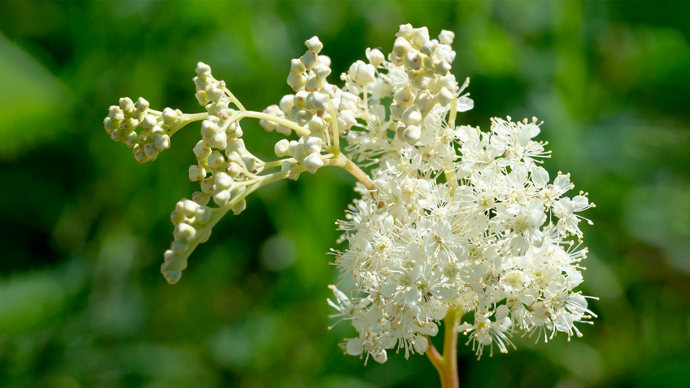Common names: meadowsweet, bittersweet
Scientific name: Filipendula ulmaria
Family: Rosaceae
Origin: native
Flowering season: June to September
Habitat: wet woodland, grassland, heathland and moorland
Sweet by name, sweet by nature. Meadowsweet might not be to everyone’s taste, but you’re unlikely to mistake the sickly sweet and frothy flower in damp woodland and bubbling out of damp ditches.
Common names: meadowsweet, bittersweet
Scientific name: Filipendula ulmaria
Family: Rosaceae
Origin: native
Flowering season: June to September
Habitat: wet woodland, grassland, heathland and moorland
An upright perennial plant, meadowsweet grows to a height of 120cm.
Leaves: compound, with up to 5 pairs of leaflets and a 3-lobed leaflet at the tip. Dark green on the top and greyish below. Leaflets are deeply veined and doubly serrated (toothed) along the edges. The leaves are arranged on alternate sides of the stem.
Flowers: are small and white or creamy-yellow and in large, frothy clusters or flower heads known as cymes. Each single flower is only 5-10mm in diameter. Each flower has long stamen giving a fuzzy appearance.
Not to be confused with: the related dropwort has straight fruits (whereas meadowsweet has twisted, spiral-like fruits. Dropwort also tends to grow on drier ground.
Meadowsweet flourishes in damp soil in grassland and heathland and in areas where water levels rise and fall. You might spot it in a damp meadow or on a riverbank.
Look out for them in bloom between June and September.
Meadowsweet is the food plant for the larvae of several moth species including the emperor moth, grey pug, Hebrew character, lime-speck pug, mottled beauty, and the satellite. Many species of insects are attracted to the flowers.

Credit: Brian Hird (Wildflowers) / Alamy Stock Photo
Meadowsweet has painkilling properties thanks to compounds similar to aspirin. It was steeped in water as a relieving tea before medicines for pain were widespread.
It’s also edible and can be used as flavouring in a similar way to elderflower.
It was once valued for its lasting fragrance; the dried flowers were strewn across floors to perfume the home. It was also used in Anglo-Saxon times to flavour mead.
Meadowsweet was a favourite of Queen Elizabeth I, who used the plant instead of straw on her chamber floors.
Meadowsweet is common, it is not currently considered to be under threat.
Keep exploring